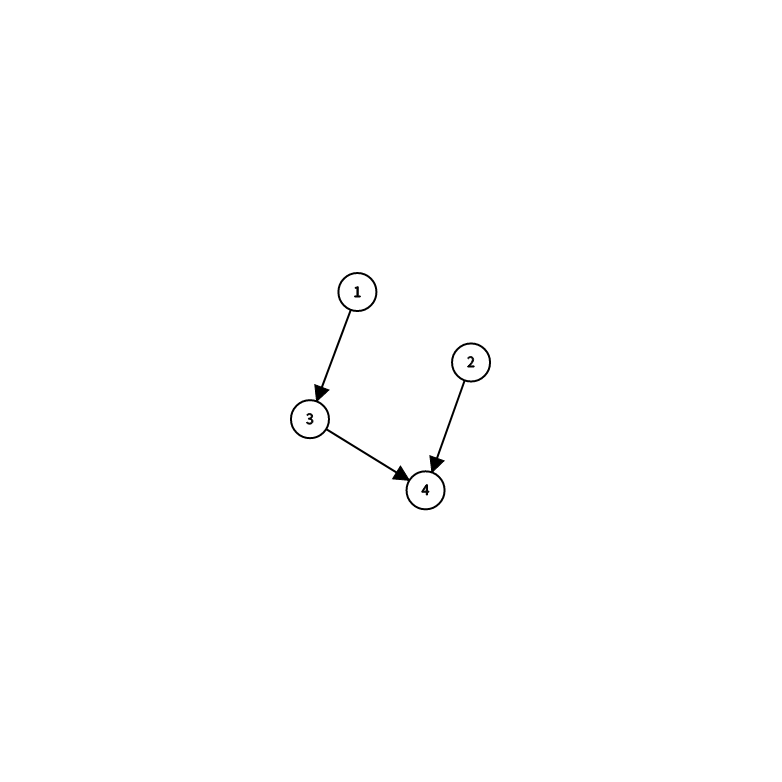题解
一道,神奇的题= =
我们考虑正难则反,我们求去掉这些边后有多少图不是强连通的
怎么求呢,不是强连通的图缩点后一定是一个DAG,并且这个DAG里面有两个点

我们想一下,如果我们把1当成入度为0的点,随便造出个图,可以是这个图吧
如果把2当成入度为0的点,随便造出个图,也可以是这个图吧
把1和2当成入度为0的点,随便造出个图,还可以是这个图吧……
那么这像什么,容斥啊
以下的点说的都是缩点后的点
奇数个入度为0的点就是+,偶数个入度为0的点就是-
那么我们就有了一个精妙的容斥!
设(f[S])为点集S是强连通分量的方案数
设(g[S]) ……是……
定义可能很奇怪,是容斥出来的,点集S的系数
嗯,这么考虑,我们知道了S这个点全是入度为0的点,那么剩下的造图的过程,就是S这个点集向外延伸的边,和除S中的点之外的点之间的边,有或没有,乘上一个2的指数幂就好
那么,怎么知道S这个系数呢???
我们考虑S中包含一个编号最小的点u的强连通分量,且入度为0
假如这个点的集合是T,T包含u
那么(g[S] = g[S] - g[S ^ T] * f[T]),咦,为什么是减法
因为(g[S ^ T])容斥的系数,在多了一个联通块后,所有的奇偶性都改变了,那么+-号也取反了,所以是减法
最后,我们用每个S的子集(包括S)算一遍不合法的图,用总共的图减掉就行,就是(f[S])的值
还有(g[S] += f[S])这样的话,代表整个S是一个强连通分量,S缩点后构成的入度为0的点是1个
(h[S])表示S这个点集中的边
(w[T])表示在全集是S的情况下,选择T这个点集作为缩点后入度为0的点,能向外延伸的边集
代码
#include <iostream>
#include <cstdio>
#include <vector>
#include <algorithm>
#include <cmath>
#include <cstring>
#include <map>
//#define ivorysi
#define pb push_back
#define space putchar(' ')
#define enter putchar('
')
#define mp make_pair
#define pb push_back
#define fi first
#define se second
#define mo 974711
#define MAXN 100005
#define RG register
using namespace std;
typedef long long int64;
typedef double db;
template<class T>
void read(T &res) {
res = 0;char c = getchar();T f = 1;
while(c < '0' || c > '9') {
if(c == '-') f = -1;
c = getchar();
}
while(c >= '0' && c <= '9') {
res = res * 10 + c - '0';
c = getchar();
}
res *= f;
}
template<class T>
void out(T x) {
if(x < 0) {putchar('-');x = -x;}
if(x >= 10) {
out(x / 10);
}
putchar('0' + x % 10);
}
const int MAXS = 1 << 15;
const int MOD = 1000000007;
int N,M;
int cnt[MAXS + 5],In[MAXS + 5],Out[MAXS + 5],h[MAXS + 5],w[MAXS + 5],g[MAXS + 5],f[MAXS + 5],pow2[405];
inline int inc(int a,int b) {a = a + b;if(a >= MOD) a -= MOD;return a;}
inline int mul(int a,int b) {return 1LL * a * b % MOD;}
void Init() {
read(N);read(M);
pow2[0] = 1;
for(int i = 1 ; i <= M ; ++i) {
pow2[i] = pow2[i - 1] << 1;
if(pow2[i] >= MOD) pow2[i] -= MOD;
}
for(int i = 1 ; i < MAXS ; ++i) cnt[i] = cnt[i - (i & -i)] + 1;
int u,v;
for(int i = 1 ; i <= M ; ++i) {
read(u);read(v);--u;--v;
In[1 << v] |= 1 << u;
Out[1 << u] |= 1 << v;
}
}
void Solve() {
for(int S = 1 ; S < (1 << N) ; ++S) {
if(cnt[S] == 1) {
h[S] = 0;f[S] = g[S] = 1;
continue;
}
int v = S & (-S);
h[S] = h[S ^ v] + cnt[In[v] & S] + cnt[Out[v] & S];
for(int T = (S - 1) & S ; T ; T = (T - 1) & S) {
if(T & v) {
g[S] = inc(g[S],MOD - mul(g[S ^ T],f[T]));
}
}
int rev_f = 0;
for(int T = S ; T ; T = (T - 1) & S) {
if(T == S) w[T] = 0;
else {
v = (S ^ T) & -(S ^ T);
w[T] = w[T ^ v] - cnt[Out[v] & (S ^ T)] + cnt[In[v] & T];
}
rev_f = inc(rev_f,mul(g[T],pow2[h[S ^ T] + w[T]]));
}
f[S] = inc(pow2[h[S]],MOD - rev_f);
g[S] = inc(g[S],f[S]);
}
out(f[(1 << N) - 1]);enter;
}
int main() {
#ifdef ivorysi
freopen("f1.in","r",stdin);
#endif
Init();
Solve();
return 0;
}